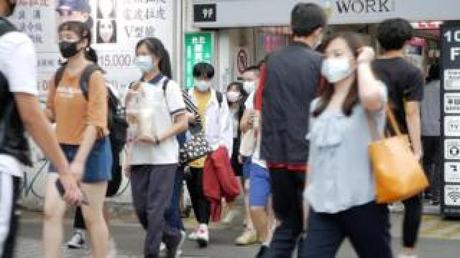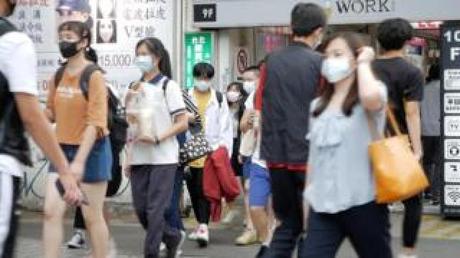

With direct flights to Wuhan and a population of 24 million people living in densely crowded cities, the prospects for Taiwan's coronavirus seemed serious.
But, to date, the disease has caused only seven lives on the island and has never been completely closed.
Its leaders attribute masks to a key role, but not for the reasons you might assume.
"Masks are something that, firstly, reminds you to wash your hands properly and, secondly, it protects you from touching your mouth - this is the main advantage for the person who wears it," explains Audrey Tang, digital minister of Taiwan.
Taiwanese citizens have been wearing masks for health and other reasons since the 1950s, but the spread of coronavirus has provoked a wave of panic buying.
To standardize demand, the masks had to be rationed as production increased from two million to 20 million items per day.
Long queues winded from pharmacies and other outlets, which represented a risk of contagion in themselves. Therefore, the government decided that the inventory level data for each location should be made public.
To do this, Ms. Tang's ministry launched a platform that any supplier could keep up to date with their stock numbers.
Then, the Taiwan hacker community, with which the government had built strong relationships for years, intervened.
He began drawing on the data, which had been made public, to build a series of "mask maps" in real time.
These provided residents with updated information on where they could find the masks near their homes or work, with details of how many were available for purchase.
Mutual trust
As the popularity of the maps grew, more and more teams of hackers joined and added features like voice control for visually impaired users.
More than 10 million people have used mask apps.
The result, Tang says, is that nowadays only a minority don't wear them, and even now they "feel the social pressure" to do so.
"This is the first time that hackers have really thought they were like the designers of civil engineering projects," he adds.
"Because we trust people a lot, sometimes people trust them."
Relations between the Taiwanese authorities and the general public have not always been so smooth.
There were complaints following the serious acute respiratory syndrome epidemic of 2003 (Sars), when the response was "very chaotic," says Tang.
Part of the problem was that the government had failed to create a centralized body to coordinate its response.
Leaders learned the lesson and in 2004 established the National Health Command Center to ensure that government agencies worked better together in future crises. They also ordered that stocks of personal protective equipment (PPE) be kept at a level sufficient to address the initial stage of any future pandemic.
In 2014, there was more civil strife when citizens stormed the parliament building to protest a trade deal that many thought had brought Taiwan too close to China. Above all, they opposed how they had not been heard by the powerful.
The event became known as the sunflower revolution because protesters used the flower as a symbol of hope.
Among them were a gang of civilian hackers, who collaborated on programs that used available data to solve the challenges that society faced.
Subsequently, the government invited them to find ways to crowdsourcing and analyze citizens' opinions and insights, to better influence the creation of new laws.
Tang - herself a civic hacker at the time - suggests that the Taiwanese government was prepared to counter the threat of coronavirus, in part, because past crises had taught him the value of being more responsive.
So when a "netizen" republished a Taiwanese warning of a Sars-like illness in the early hours of late December to the Taiwanese equivalent of Reddit, people voted in favor - and the authorities paid attention.
That message turned out to be from Dr. Li Wenliang, the Chinese informant who first felt the world of Covid-19.
Shortly thereafter, targeted sections of the population were tested and traced if they had just returned from Wuhan and recently had health problems. It worked - and the virus was stopped in its tracks.
Meme v disinformation
There are other reasons why Taiwan has been able to suppress Covid-19.
Earlier this week, Chien-Jen Chen - a former vice president of the island and a famous epidemiologist - told British parliamentarians that a well-designed contact tracking system and the application of strict quarantine rules to incoming visitors an important role.
But he also said that the nature of the island's "hyper-democracy" - and the efforts made by its health leaders to gain public trust - were key factors in its success.
Those in power are not only sensitive to citizens' voices, but also to memes and other messages they share.
It helped the government to counter the false claims that the material used to make the masks was the same as that found in the toilet paper. In response, the Taiwanese Premier published a self-deprecating comic, which showed his basic jolt, along with an explanation of the different sources from which toilet paper and masking paper came from.
"It went absolutely viral," says Tang, of the government's strategy called "voice humor."
The strategy uses engaging tweet length posts, designed to spread faster than disinformation.
"Most people are likely to see ... the clarification message before the rumor," explains Tang.
"Then they'll have flock immunity - or, in the case of a meme, nerd immunity," he jokes.
At a time when trust in the authorities is wearing away elsewhere, Tang suggests that Taiwan illustrates an alternative to the top-down approach, in case a second wave of viruses strikes.
But "that decision has to be made by all society," he adds.
